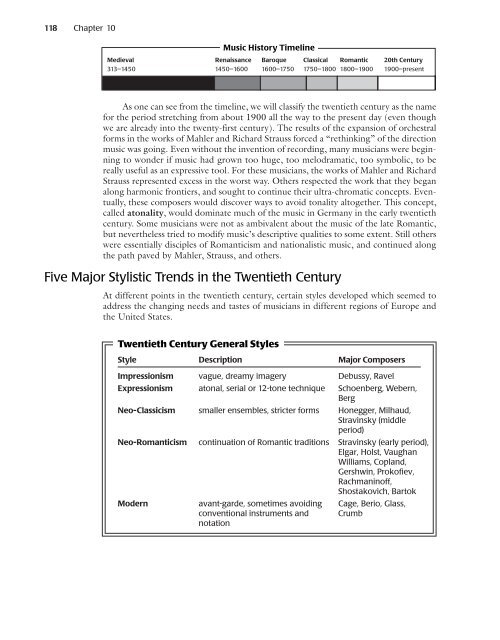Composer Profile - Activefolio
Composer Profile - Activefolio
Composer Profile - Activefolio
Create successful ePaper yourself
Turn your PDF publications into a flip-book with our unique Google optimized e-Paper software.
118 Chapter 10<br />
Music History Timeline<br />
Medieval Renaissance Baroque Classical Romantic 20th Century<br />
313–1450 1450–1600 1600–1750 1750–1800 1800–1900 1900–present<br />
As one can see from the timeline, we will classify the twentieth century as the name<br />
for the period stretching from about 1900 all the way to the present day (even though<br />
we are already into the twenty-first century). The results of the expansion of orchestral<br />
forms in the works of Mahler and Richard Strauss forced a “rethinking” of the direction<br />
music was going. Even without the invention of recording, many musicians were beginning<br />
to wonder if music had grown too huge, too melodramatic, too symbolic, to be<br />
really useful as an expressive tool. For these musicians, the works of Mahler and Richard<br />
Strauss represented excess in the worst way. Others respected the work that they began<br />
along harmonic frontiers, and sought to continue their ultra-chromatic concepts. Eventually,<br />
these composers would discover ways to avoid tonality altogether. This concept,<br />
called atonality, would dominate much of the music in Germany in the early twentieth<br />
century. Some musicians were not as ambivalent about the music of the late Romantic,<br />
but nevertheless tried to modify music’s descriptive qualities to some extent. Still others<br />
were essentially disciples of Romanticism and nationalistic music, and continued along<br />
the path paved by Mahler, Strauss, and others.<br />
Five Major Stylistic Trends in the Twentieth Century<br />
At different points in the twentieth century, certain styles developed which seemed to<br />
address the changing needs and tastes of musicians in different regions of Europe and<br />
the United States.<br />
Twentieth Century General Styles<br />
Style Description Major <strong>Composer</strong>s<br />
Impressionism vague, dreamy imagery Debussy, Ravel<br />
Expressionism atonal, serial or 12-tone technique Schoenberg, Webern,<br />
Berg<br />
Neo-Classicism smaller ensembles, stricter forms Honegger, Milhaud,<br />
Stravinsky (middle<br />
period)<br />
Neo-Romanticism continuation of Romantic traditions Stravinsky (early period),<br />
Elgar, Holst, Vaughan<br />
Williams, Copland,<br />
Gershwin, Prokofiev,<br />
Rachmaninoff,<br />
Shostakovich, Bartok<br />
Modern avant-garde, sometimes avoiding Cage, Berio, Glass,<br />
conventional instruments and<br />
notation<br />
Crumb



